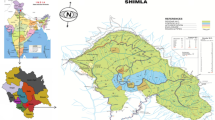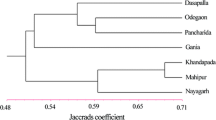Abstract
Species richness and density of understory plants were investigated in eight 1 ha plots, distributed one each in undisturbed and disturbed tropical evergreen, semi-evergreen, deciduous and littoral forests of Little Andaman island, India, which falls under one of the eight hottest hotspots of Biodiversity in the world viz. the Indo-Burma. One hundred 1 m−2 quadrats were established in each 1 ha plot, in which all the understory plants (that include herbs, undershrubs, shrubs and herbaceous climbers) were enumerated. The total density of understory plants was 6,812 individuals (851 ha−1) and species richness was 108 species, representing 104 genera and 50 families. Across the four forest types and eight study plots, the species richness ranged from 10 to 39 species ha−1. All the disturbed sites harbored greater number of species than their undisturbed counterparts. Herbs dominated by species (63%) and density (4,259 individuals). The grass Eragrostis tenella (1,860 individuals; IVI 40), the invasive climber Mikania cordata (803; IVI 20) and the shrub Anaxagorea luzonensis (481; IVI 17.5) were the most abundant species. Poaceae, Asteraceae, Acanthaceae, Orchidaceae and Euphorbiaceae constituted the species-rich families represented by 6 species each. The species-area curves attained an asymptote at 0.8 ha level except in sites DD and DL, indicating 1 ha plot is not sufficient to capture all the understory species in disturbed forests. The alien weeds formed about one-fourth of the species richness (31 species; 28%) and density (1,926 individuals; 28.3%) in the study sites, indicating the extent of weed invasion and the attention required for effective conservation of the native biodiversity of the fragile island forest ecosystem.





Similar content being viewed by others
References
Annaselvam J, Parthasarathy N (1999) Inventories of understory plants in a tropical evergreen forest in the Anamalais, Western Ghats, India. Ecotropica 5:197–211
Bhat DM, Murali KS (2001) Phenology of understory species of tropical moist forest of Western Ghats region of Uttara Kannada district in South India. Curr Sci 81:799–805
Bhat HR, Utkarsh G (1999) Herbs species diversity of Western Ghats. In: Hussain HA, Achar KP (eds) Biodiversity of the Western Ghats complex of Karnataka: resource potential and sustainable utilization. Biodiversity Initiative Trust, Mangalore, pp 65–93
Bobo KS, Waltert M, Sainge NM, Njokagbor J, Fermon H, Muhlenberg M (2006) From forest to farmland: species richness patterns of trees and understory plants along the gradients of forest conversion in Southwestern Cameroon. Biodivers Conserv 15:4097–4117. doi:10.1007/s10531-005-3368-6
Campbell DG (1994) Scale and pattern of community structure in Amazonian rainforests. In: Edwards PJ, May RM, Web NR (eds) Larger scale ecology and conservation biology. Blackwell, Oxford
Champion HG, Seth SK (1968) A revised survey of the forest types of India. Manager of Publications, New Delhi
Chittibabu CV, Parthasarathy N (2000) Understory plant diversity in a tropical evergreen forest in Kolli hills, Eastern Ghats, India. Ecotropica 6:129–140
Colwell RK (1997) EstimateS: Statistical estimation of species richness and shared species from samples, version 8. User’s guide and applications. Published at: http://viceroy.eeb.uconn.edu/estimates. Cited on 15 July 2008
Connell JH (1978) Diversity in tropical rainforest and coral reefs. Science 199:1302–1310. doi:10.1126/science.199.4335.1302
Costa F, Magnusson W (2002) Selective logging effects on abundance, diversity, and composition of tropical understory herbs. Ecol Appl 12:807–819. doi:10.1890/1051-0761(2002)012[0807:SLEOAD]2.0.CO;2
Curtis JT, Mclntosh RP (1951) The interrelation of certain analytic and synthetic phytosociological characters. Ecology 31:434–455. doi:10.2307/1931497
Gentry AW (1990) Four neotropical rainforests. Yale University Press, New Haven, CT
Gentry AH, Dodson C (1987) Contribution of non-trees to species richness of tropical rainforest. Biotropica 19:149–156. doi:10.2307/2388737
Gopisundar KS (1997) Abundance, diversity and distribution of ground herbs in a tropical lowland evergreen rainforest at Agumbe, Karnataka. M.Sc. Thesis, Pondicherry University, Puducherry
Gordon JE, Newton AC (2006) Efficient floristic inventory for the assessment of tropical tree diversity: a comparative test of four alternative approaches. For Ecol Manag 237:564–573
Hajra PK, Uniyal BP, Rao PSN (eds) (1999) Flora of Andaman and Nicobar Islands, vol 1. Botanical Survey of India, Kolkata
Hall JB, Swaine MD (1981) Distribution and ecology of vascular plants in a tropical rain forest. W. Junk, The Hague
Hooker JD (1882–1897) Flora of British India. L. Reeve and Co., London
Kiew R (1978) Floristic components of the ground flora of a tropical lowland rainforest at Gunung Mulu National Park, Sarawak. Pertanica 1:112–119
Laska MS (1997) Structure of understory assemblages in adjacent secondary forest and old growth tropical wet forests, Costa Rica. Biotropica 29:29–37. doi:10.1111/j.1744-7429.1997.tb00003.x
Leopold CA, Salazar J (2008) Understory species richness during restoration of wet tropical forest in Costa Rica. Ecol Res 26:22–26
Levey DJ (1988) Tropical wet forest treefall gaps and distributions of understory birds and plants. Ecology 69:1076–1089. doi:10.2307/1941263
Mori SA, Boom BM, Carvalho AM, DosSantos TS (1983) Southern Bahian moist forests. Bot Rev 49:155–232. doi:10.1007/BF02861011
Muthuramkumar S, Ayyappan N, Parthasarathy N, Mudappa D, Shankar Raman TR, Arthur Selwyn M et al (2006) Plant community structure in tropical rainforest fragments of the Western Ghats, India. Biotropica 38:143–160. doi:10.1111/j.1744-7429.2006.00118.x
Newbery D, Mc C, Campbell EJF, Proctor J, Still MJ (1996) Primary lowland dipterocarp forest at Danum valley, Sabah, Malaysia, species composition and patterns in the understory. Vegetatio 122:193–220. doi:10.1007/BF00044700
Padalia H, Chauhan N, Porwal MC, Roy PS (2004) Phytosociological observations on tree species diversity of Andaman Islands, India. Curr Sci 87:799–806
Parkinson CE (1923) A forest flora of the Andaman Islands. Bishen Singh and Mahendrapal Singh, Dehradun
Poulsen AD (1996a) The herbaceous ground flora of the Batu Apoi forest Reserve, Brunei Darussalam. In: Edwards DS, Booth WE, Choy SC (eds) Tropical rain forest research-current issues. Kluwer Academic Publishers, Dordrecht, pp 43–57
Poulsen AD (1996b) Species richness and diversity of ground herbs within a plot of lowland rainforest in north-west Borneo. J Trop Ecol 12:843–851
Poulsen AD, Balslev H (1991) Abundance and cover of ground herbs in the Amazonian rainforest. J Veg Sci 2:315–322. doi:10.2307/3235922
Poulsen AD, Nielsen IH (1995) How many ferns are there in 1 ha of tropical rain forest? Am Fern J 85:29–35. doi:10.2307/1547678
Poulsen AD, Pendry CA (1995) Inventories of ground herbs at three altitudes on Bukit Belalong, Brunei, Borneo. Biodivers Conserv 4:745–757. doi:10.1007/BF00158867
Ram J, Kumar A, Bhatt J (2004) Plant diversity in six forest types of Uttaranchal, Central Himalaya, India. Curr Sci 86:975–978
Ramadhanil R, Tjitrosoedirdjo SS, Setiadi D (2008) Structure and composition of understory plant assemblages of six land use types in the Lore Lindau National Park, Central Sulawesi, Indonesia. Bangladesh J Plant Taxon 15:1–12
Ramanamurthy MV, Sundaramoorthy S, Pare Y, Ranga Rao V, Mishra P, Bhat M et al (2005) Inundation of sea water in Andaman & Nicobar Islands and parts of Tamil Nadu coast during 2004 Sumatra tsunami. Curr Sci 88:1736–1740
Rao MKV (1986) A preliminary report on the angiosperms of Andaman and Nicobar Islands. J Econ Taxon Bot 8:107–184
Rasingam L, Parthasarathy N (2008) Tree diversity assessment in four undisturbed and adjacent disturbed tropical forests of Little Andaman Island, India. Trop Ecol 49
Richards PW (1996) The tropical rain forest, 2nd edn. Cambridge University Press, Cambridge
Siebert S (2002) From shade to sun-grown perennial crops in Sulawesi, Indonesia: implications for biodiversity conservation and soil fertility. Biodivers Conserv 11:1889–1902. doi:10.1023/A:1020804611740
Smith RE (1970) A comprehensive review of herbaceous layer ecology. Divers Distrib 12:222–223
Svenning JC (2000) Small canopy gaps influence plant distributions in the rainforest understory. Biotropica 32:252–261
Tripathi KP, Tripathi S, Selvan T, Kumar K, Singh KK, Mehrotra S et al (2004) Community structure and species diversity of Saddle Peak forest in Andaman Island. Trop Ecol 45:241–250
Tuomisto H, Poulsen AD (1996) Influence of edaphic specialization of pteridophytic distribution in neotropical rainforests. J Biogeogr 23:283–293. doi:10.1046/j.1365-2699.1996.00044.x
Tuomisto H, Poulsen AD, Moran RC (1998) Edaphic distribution of some species of the fern genus Adiantum in Western Amazonia. Biotropica 30:392–399. doi:10.1111/j.1744-7429.1998.tb00073.x
Tuomisto H et al (2002) Distribution and diversity of pteridophytes and Melastomataceae along edaphic gradients in Yasuni National Park, Ecuadorian Amazoni. Biotropica 34:516–533
Turner IM, Tan MTW, Chua KS (1996) Relationship between herb layer and canopy composition in a tropical rain forest successional mosaic in Singapore. J Trop Ecol 12:843–851
Upadhaya K, Pandey HN, Tripathi RS (2006) Understory plant diversity in subtropical humid forest of Meghalaya. Int J Ecol Environ Sci 32:207–209
Acknowledgments
We thank the Director, Botanical Survey of India, Kolkata and Joint Director, Botanical Survey of India, Andaman and Nicobar Circle, Port Blair for allowing us to consult the herbaria and officials of Andaman and Nicobar Island Forest Plantation and Development Corporation Limited, Port Blair for field support.
Author information
Authors and Affiliations
Corresponding author
Rights and permissions
About this article
Cite this article
Rasingam, L., Parthasarathy, N. Diversity of understory plants in undisturbed and disturbed tropical lowland forests of Little Andaman Island, India. Biodivers Conserv 18, 1045–1065 (2009). https://doi.org/10.1007/s10531-008-9496-z
Received:
Accepted:
Published:
Issue Date:
DOI: https://doi.org/10.1007/s10531-008-9496-z




